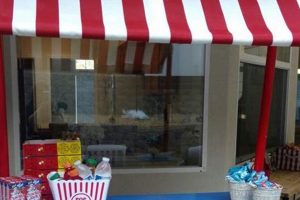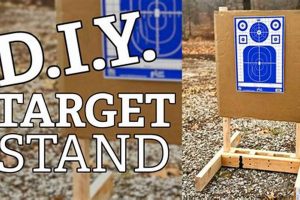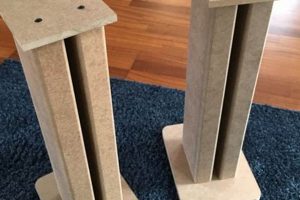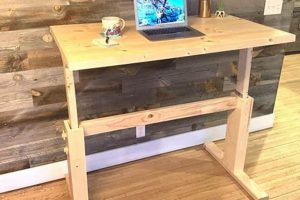A self-constructed support structure designed to hold a 75-gallon aquatic habitat is a common project among hobbyists. These projects involve individuals creating a load-bearing framework capable of safely supporting the considerable weight of a filled aquarium. For example, a person might choose to build a wood frame with a reinforced top to accommodate the dimensions and weight of the tank.
Constructing a customized base offers several advantages. It allows for tailoring the design to specific aesthetic preferences and spatial constraints. Furthermore, it can provide cost savings compared to commercially manufactured options, particularly when utilizing readily available materials. Historically, the practice of building these structures stems from a desire for personalization and control over the aquarium’s presentation within a living space.
The subsequent sections will delve into essential considerations for building a safe and reliable support, including material selection, structural design principles, and crucial construction techniques necessary to ensure the stability and longevity of the entire setup.
Essential Guidelines for Constructing a Stable Aquarium Base
The following guidelines provide critical insights for ensuring the creation of a safe and structurally sound support for a 75-gallon aquarium. Adherence to these points is essential for preventing potential failures and ensuring the long-term stability of the aquatic display.
Tip 1: Prioritize Material Selection: Opt for lumber species known for their strength and resistance to moisture, such as pressure-treated pine or hardwood. Avoid particleboard or MDF, as these materials are prone to water damage and structural weakness.
Tip 2: Employ a Robust Structural Design: A frame featuring vertical supports at each corner and intermediate supports along longer spans is recommended. Consider a design incorporating a solid top capable of distributing the tank’s weight evenly across the support structure.
Tip 3: Utilize Appropriate Fasteners: Employ screws designed for structural applications. Wood screws with a length of at least 2.5 inches are generally suitable for joining framing members. Avoid relying solely on nails or staples, as they lack the necessary holding power.
Tip 4: Ensure Level Construction: Use a level throughout the assembly process to guarantee a perfectly horizontal and vertical structure. Any deviation from level can create uneven stress distribution and compromise stability.
Tip 5: Reinforce Key Joints: Employ metal brackets or gussets to strengthen critical joints, particularly corners and areas where vertical supports meet the frame. This reinforcement enhances the overall rigidity and load-bearing capacity.
Tip 6: Apply a Moisture Barrier: Seal all exposed wood surfaces with a waterproof sealant or paint to prevent moisture absorption and subsequent warping or decay. This is especially important in areas prone to spills or condensation.
Tip 7: Conduct Load Testing: Before placing the aquarium on the constructed base, subject the structure to a simulated load test. Fill the support with weights approximating the weight of a filled 75-gallon aquarium to verify its stability and identify any potential weaknesses.
These guidelines emphasize the significance of sound engineering principles and meticulous craftsmanship in constructing a reliable aquarium support. Careful attention to these details will contribute to a safe and aesthetically pleasing aquatic display.
The next section will discuss potential challenges that may arise during this process and offer strategies to address them effectively.
1. Material Load Capacity
Material load capacity is a paramount consideration in the context of constructing a base to hold a 75-gallon aquarium. The weight exerted by a filled aquarium necessitates careful evaluation of the structural materials used in its construction. Insufficient load capacity directly increases the risk of structural failure, leading to potential damage and safety hazards.
- Wood Species Selection
The choice of wood species dictates the overall load-bearing capability. Softwoods, such as pine, possess lower load capacities compared to hardwoods like oak or maple. The selected wood must possess a sufficient modulus of elasticity and bending strength to withstand the prolonged stress imposed by the aquarium’s weight. For instance, a design employing pine might require significantly larger dimensions compared to one utilizing oak to achieve a comparable safety margin.
- Fastener Strength and Spacing
Fasteners, including screws and bolts, play a critical role in transferring load between structural members. Insufficient fastener size or inadequate spacing can create weak points within the structure, reducing the overall load capacity. Consider a scenario where undersized screws are used to join frame components; these fasteners may shear under stress, leading to joint failure and potential collapse. Structural screws designed for high shear strength are recommended.
- Safety Factor Implementation
A safety factor is a multiplier applied to the calculated load requirements to account for unforeseen stresses, material imperfections, and construction variances. A commonly employed safety factor of 2 or greater dictates that the stand be capable of supporting at least twice the weight of the filled aquarium. This ensures a buffer against unexpected loads or gradual material degradation over time.
- Material Degradation Over Time
The long-term performance of the support structure is influenced by potential material degradation due to moisture exposure, insect infestation, or fungal decay. Untreated wood, for example, may gradually lose its load-bearing capacity as it absorbs moisture and becomes susceptible to rot. Implementing preventative measures, such as applying a waterproof sealant and selecting decay-resistant materials, is crucial for maintaining the structure’s integrity over its lifespan.
The interplay of these factors directly influences the safety and reliability of the aquarium setup. Neglecting any of these aspects compromises the structural integrity and presents a significant risk of failure. Thorough assessment of material properties, proper construction techniques, and the incorporation of a suitable safety factor are essential for ensuring the long-term stability of the self-constructed base.
2. Structural Joint Integrity
Structural joint integrity is a critical factor in the design and construction of any support for a 75-gallon aquarium. The joints, where individual structural members connect, are often the weakest points in a framework. Ensuring their strength and stability is paramount to preventing catastrophic failure and ensuring the safety of the aquarium and its surroundings.
- Joint Type Selection
The type of joint employed significantly impacts its overall strength. Butt joints, while simple to execute, offer minimal resistance to shear and tensile forces. Lap joints, mortise and tenon joints, and reinforced corner joints provide significantly greater load-bearing capacity due to increased surface area for adhesive bonding and mechanical fastening. The selection of an appropriate joint type should align with the anticipated load and stress distribution within the structure supporting the aquarium.
- Fastener Application and Placement
The effective use of fasteners, such as screws, bolts, or nails, is essential for maintaining joint integrity. The type, size, and spacing of fasteners must be carefully considered to ensure adequate holding power. Overdriving screws can weaken the surrounding wood fibers, while insufficient fastener density can compromise the joint’s resistance to shear forces. A staggered fastener pattern and appropriate pilot hole drilling can optimize fastener performance and prevent wood splitting, particularly when working with hardwoods.
- Adhesive Bonding Characteristics
The use of adhesives can significantly enhance joint strength and rigidity. Wood glue, epoxy, or construction adhesives can fill gaps, distribute stress, and provide a secondary bonding mechanism in addition to mechanical fasteners. The selected adhesive should be compatible with the materials being joined and possess adequate water resistance to withstand potential moisture exposure. Proper clamping during the adhesive curing process is crucial to ensure optimal bond formation and joint stability.
- Reinforcement Strategies
Reinforcement techniques can augment the strength and durability of joints in high-stress areas. Metal brackets, gussets, or corner braces can distribute loads and prevent joint deformation under heavy weight. Strategically placed reinforcements can significantly increase the overall load capacity of the framework, providing an additional margin of safety for supporting a 75-gallon aquarium. The use of these reinforcements requires careful planning and precise installation to ensure their effectiveness.
The robust design and execution of structural joints are fundamental to the success of any “diy 75 gallon aquarium stand.” Proper joint selection, fastener application, adhesive bonding, and reinforcement strategies collectively contribute to a stable and reliable structure capable of safely supporting the weight of the aquarium and mitigating the risk of potential structural failure.
3. Moisture Resistance Treatment
Moisture resistance treatment is a critical aspect in the construction of a self-made base for a 75-gallon aquarium. The constant presence of water, potential spills, and humidity associated with aquariums create an environment conducive to wood decay, corrosion of metal components, and overall structural weakening. Implementing effective moisture resistance strategies is therefore essential for ensuring the longevity and safety of the stand.
- Selection of Water-Resistant Materials
The initial material selection significantly impacts the need for extensive post-construction treatment. Utilizing naturally water-resistant wood species, such as cedar or redwood, provides inherent protection against moisture absorption. Alternatively, pressure-treated lumber undergoes a chemical process that renders it resistant to rot and insect infestation. For example, a stand constructed from untreated pine would necessitate more rigorous sealing compared to one built from cedar.
- Application of Waterproof Sealants
Waterproof sealants create a barrier that prevents moisture from penetrating the wood fibers. Polyurethane, epoxy, and marine-grade varnishes are commonly employed for this purpose. These sealants form a durable, water-impermeable layer that protects the wood from spills, condensation, and humidity. For instance, applying multiple coats of polyurethane to all exposed wood surfaces, including edges and undersides, minimizes water absorption and swelling.
- Protective Coating for Metal Components
If the stand incorporates metal elements, such as fasteners or support brackets, protecting them from corrosion is vital. Rust-resistant coatings, such as zinc plating or powder coating, prevent oxidation and degradation of the metal. For example, using stainless steel fasteners eliminates the risk of rust and ensures the long-term structural integrity of the joints.
- Ventilation and Airflow Considerations
Promoting adequate ventilation around the aquarium stand helps reduce humidity and prevent moisture buildup. Incorporating ventilation openings or spacing the stand slightly away from walls allows for airflow, minimizing the potential for condensation and mold growth. For instance, designing the stand with open shelving or leaving a gap between the back of the stand and the wall facilitates air circulation.
The implementation of comprehensive moisture resistance measures is not merely an aesthetic consideration but a fundamental requirement for ensuring the long-term stability and safety of a homemade support. Neglecting these treatments can lead to premature decay, structural weakening, and ultimately, the failure of the support, resulting in damage to the aquarium and surrounding area. A proactive approach to moisture protection safeguards the investment and ensures the longevity of the aquatic display.
4. Dimensional Accuracy Imperative
Dimensional accuracy is a non-negotiable requirement in the context of constructing a self-made base for a 75-gallon aquarium. The structural integrity and stability of the entire setup depend on the precise execution of measurements and cuts during the construction process. Deviations from specified dimensions can lead to uneven weight distribution, compromised joint strength, and ultimately, a catastrophic failure. The aquariums footprint must be accurately replicated in the support structure to ensure complete and even contact, preventing localized stress concentrations. For instance, if the base is even a quarter of an inch out of square, one corner of the aquarium will bear a disproportionate amount of weight, potentially leading to cracking or joint separation in the base, and stress fractures in the aquarium itself.
Practical implications of dimensional inaccuracies extend beyond immediate structural concerns. An unlevel support structure introduces gravitational stress vectors that are not accounted for in the aquariums design. This can create asymmetrical pressure on the glass panels, increasing the risk of leaks or complete failure. Furthermore, dimensional errors can complicate the integration of filtration systems, plumbing, and other essential aquarium components, leading to operational inefficiencies and maintenance difficulties. Consider a scenario where the interior dimensions of the cabinet are slightly smaller than planned; this could impede the installation of a sump filter or require modifications that weaken the structural integrity of the base. Similarly, inaccurately placed support braces may not effectively distribute the aquarium’s weight, negating their intended function.
In summary, meticulous attention to dimensional accuracy is not merely a matter of aesthetics or convenience but a fundamental engineering principle in the construction of an aquarium support structure. Precise measurements, accurate cuts, and careful assembly are indispensable for ensuring the safety, stability, and longevity of the entire aquatic system. Neglecting this aspect introduces significant risks and compromises the entire project, potentially resulting in substantial financial losses and environmental damage.
5. Weight Distribution Uniformity
Weight distribution uniformity represents a critical engineering consideration in the context of a self-constructed support structure for a 75-gallon aquarium. The consistent and even dispersal of the aquarium’s substantial load across the entire support frame is paramount to preventing localized stress concentrations that could lead to structural failure. The following points outline key facets of ensuring uniform weight distribution.
- Planar Surface Integrity
The supporting surface must exhibit near-perfect planarity. Any warping, bowing, or unevenness in the surface can concentrate the aquarium’s weight on specific points, exceeding the material’s compressive strength in those locations. For example, a warped plywood top would transfer the load disproportionately to the high points, potentially causing cracking in the aquarium’s glass base and ultimately compromising the entire structure.
- Vertical Support Symmetry
Vertical supports must be symmetrically arranged and equally spaced to distribute the load evenly across the base. Asymmetrical placement of supports creates an uneven load path, increasing stress on certain members. Consider a scenario where one side of the stand has two supports while the other has only one; the side with a single support would bear significantly more weight, increasing the risk of buckling or failure.
- Joint Load Transfer Efficiency
The joints connecting structural members must be designed to efficiently transfer the load. Weak or poorly constructed joints can act as bottlenecks, concentrating stress and preventing uniform distribution. For instance, butt joints relying solely on fasteners may be insufficient to transfer the load effectively, requiring reinforcement with metal brackets or gussets to ensure uniform load transfer between members.
- Material Homogeneity and Consistency
Variations in material density or strength can disrupt weight distribution uniformity. For example, using lumber with knots or inconsistent grain patterns can create localized weak points, leading to uneven stress distribution. Employing consistent grades of lumber and carefully inspecting each piece for defects ensures that the load is distributed evenly across the entire structure.
These considerations collectively underscore the importance of precision and meticulous planning in the self-construction of an aquarium base. Effective weight distribution uniformity minimizes stress concentrations, maximizes the structural integrity of the frame, and ultimately ensures the long-term stability and safety of the 75-gallon aquarium setup. Ignoring these aspects can lead to premature failure, resulting in potentially hazardous and costly consequences.
Frequently Asked Questions Regarding the Construction of a 75-Gallon Aquarium Base
The following questions and answers address common concerns and provide clarification on critical aspects related to the building of a stable and reliable structure for a 75-gallon aquarium.
Question 1: What is the minimum load capacity required for a base designed to support a filled 75-gallon aquarium?
A support must possess a minimum load capacity of approximately 750 pounds. This accounts for the weight of the aquarium, substrate, water, and associated equipment. A safety factor of at least 2.0 is recommended, meaning the structure should ideally be capable of supporting 1500 pounds to accommodate unforeseen stress and material degradation over time.
Question 2: Which wood species are most suitable for building an aquarium base?
Hardwoods, such as oak, maple, or birch, are generally preferred due to their superior strength and resistance to moisture. Pressure-treated lumber is also a viable option, but it is essential to ensure that the treatment chemicals are non-toxic to aquatic life and that the wood is thoroughly sealed. Softwoods, like pine, can be used but require significantly larger dimensions and additional reinforcement to achieve comparable load-bearing capacity.
Question 3: What type of fasteners should be used in the construction of an aquarium base?
Structural screws, specifically designed for high shear strength and holding power, are highly recommended. Avoid relying solely on nails or staples, as they lack the necessary strength to ensure long-term structural integrity. Screws should be of sufficient length (at least 2.5 inches) to penetrate deeply into the framing members.
Question 4: How can moisture damage be prevented in an aquarium base?
Applying multiple coats of a waterproof sealant, such as polyurethane or epoxy, to all exposed wood surfaces is crucial. Paying particular attention to edges and undersides is essential to prevent moisture absorption. Utilizing water-resistant materials, such as cedar or pressure-treated lumber, can further mitigate the risk of water damage. Proper ventilation around the base also helps to reduce humidity and prevent condensation.
Question 5: Is it necessary to reinforce the corners of the aquarium base?
Reinforcing the corners is highly advisable, as these areas are subjected to significant stress. Metal brackets, gussets, or corner braces can distribute loads and prevent joint deformation. Such reinforcement significantly increases the overall load capacity and provides an added margin of safety.
Question 6: How can level construction be ensured?
Using a level throughout the assembly process is paramount. Checking both horizontal and vertical planes ensures that the structure is perfectly aligned. Any deviations from level can create uneven stress distribution and compromise stability. Shims can be used to correct minor imperfections in the floor or foundation upon which the support rests.
These FAQs highlight critical considerations in ensuring a structurally sound and safe support. Implementing best practices and heeding these guidelines promotes a successful and lasting aquarium setup.
The subsequent section will explore advanced techniques for enhancing the aesthetic appeal of a self-constructed aquarium support.
diy 75 gallon aquarium stand
The preceding discussion has meticulously examined the multifaceted considerations inherent in the construction of a support for a 75-gallon aquarium. Material selection, structural joint integrity, moisture resistance treatment, dimensional accuracy, and uniform weight distribution have been presented as crucial elements impacting the safety and longevity of the entire aquatic system. The synthesis of these factors constitutes the core foundation for a reliable and aesthetically pleasing display.
Given the considerable weight and inherent risks associated with supporting a large volume of water, adherence to established engineering principles and meticulous craftsmanship are not optional considerations but rather essential requirements. Prudent application of the guidelines outlined herein minimizes the potential for structural failure, ensuring the sustained integrity of both the aquarium and its surrounding environment. Further research and consultation with experienced aquarists or structural engineers are encouraged to refine specific designs and ensure optimal safety margins.







![Build a Beautiful DIY Tiered Plant Stand [Easy Guide] The DIY Hub: Creative Crafts, Repairs & Life Hacks Build a Beautiful DIY Tiered Plant Stand [Easy Guide] | The DIY Hub: Creative Crafts, Repairs & Life Hacks](https://craftingdiycenter.com/wp-content/uploads/2025/07/th-3290-300x200.jpg)